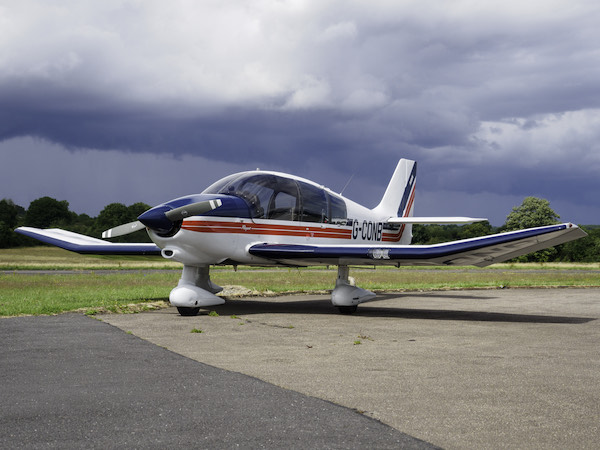
FAQs for Robin Aircraft
What is the reason for the shape of the Robin Aircraft wing?
The outer section of the Robin Aircraft wing has dihedral, which gives increased stability in bank and in turns.
The outer wing section also has a high degree of washout, so it provides minimal lift and drag in cruise, but gives extra lift at high angles of attack, improving low speed stability, maintaining aileron effectiveness near the stall, and reducing the stall speed. The inner section produces most of the lift in cruise, giving high wing loading for a smoother ride. The result is a very safe handling and responsive aeroplane that is a pleasure to fly!
Virtually all wings, other than in some military combat types, incorporate positive dihedral for stability but to twist a wing that has constant dihedral to provide washout near the outer ends is complicated and, therefore, expensive, which is why you see stall strips on the inner section of some wings. Stall strips are really a fudge to cause the inner part of the wing to stall before the outer part. The craftsmen-made wooden structure of the Robin (originally Jodel) wing effectively combines constructional and aerodynamic efficiency without the compromises of other designs.
The outer wing section also has a high degree of washout, so it provides minimal lift and drag in cruise, but gives extra lift at high angles of attack, improving low speed stability, maintaining aileron effectiveness near the stall, and reducing the stall speed. The inner section produces most of the lift in cruise, giving high wing loading for a smoother ride. The result is a very safe handling and responsive aeroplane that is a pleasure to fly!
Virtually all wings, other than in some military combat types, incorporate positive dihedral for stability but to twist a wing that has constant dihedral to provide washout near the outer ends is complicated and, therefore, expensive, which is why you see stall strips on the inner section of some wings. Stall strips are really a fudge to cause the inner part of the wing to stall before the outer part. The craftsmen-made wooden structure of the Robin (originally Jodel) wing effectively combines constructional and aerodynamic efficiency without the compromises of other designs.
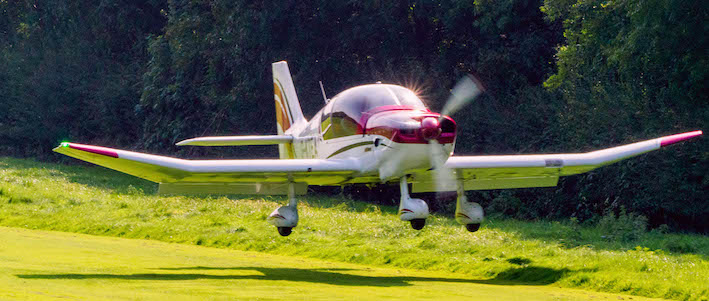
How does the Robin Aircraft 155CDI compare with the competition?
Click for the comparisonIs it necessary to hangar a Robin aircraft?
The short answer is ‘no.’ In some circumstances, parking outside is a better trade-off than hangerage. It depends on the environment and the usage of the aircraft.
An aircraft made of any material will deteriorate if kept outside, uncovered and unused for long periods. The wood structure of Robin aircraft is superior to metal and man-made composite because wood does not corrode. Note that Robin offer an unrivalled 20 year warranty on their airframes with unlimited flight hours, so no concerns about weather damage there!
Crazing of the paint on the upper wing surface due to aerodynamic lift is now eliminated by the Swiftwing, which helps to maintain a waterproof surface. So, all that will happen If a Robin is left outside is that the paint will lose its gloss more quickly, just like a car that is parked outside.
Condensation and ultraviolet light are the main two problems for all aircraft kept outside, irrespective of their construction. Condensation can cause corrosion in many areas; airframe, avionics and engine (although the plasma coating of the bores of the Continental diesel engines provides protection even there). Ultraviolet radiation will attack paint, composites, perspex and avionics. A full set of covers will protect your aircraft against the ravages of the weather, will prevent water ingress to the cabin and will reduce ultraviolet damage. Flying the aircraft frequently, avoiding parking for long periods on grass and using dehumidifier gel packs can help keep condensation at bay.
Hangerage is good if the environment is harsh, the aircraft is used little and the hangar is well ventilated but, just as for a car, putting a wet aircraft away in an enclosed space with inadequate ventilation can be worse than leaving it outside!
An aircraft made of any material will deteriorate if kept outside, uncovered and unused for long periods. The wood structure of Robin aircraft is superior to metal and man-made composite because wood does not corrode. Note that Robin offer an unrivalled 20 year warranty on their airframes with unlimited flight hours, so no concerns about weather damage there!
Crazing of the paint on the upper wing surface due to aerodynamic lift is now eliminated by the Swiftwing, which helps to maintain a waterproof surface. So, all that will happen If a Robin is left outside is that the paint will lose its gloss more quickly, just like a car that is parked outside.
Condensation and ultraviolet light are the main two problems for all aircraft kept outside, irrespective of their construction. Condensation can cause corrosion in many areas; airframe, avionics and engine (although the plasma coating of the bores of the Continental diesel engines provides protection even there). Ultraviolet radiation will attack paint, composites, perspex and avionics. A full set of covers will protect your aircraft against the ravages of the weather, will prevent water ingress to the cabin and will reduce ultraviolet damage. Flying the aircraft frequently, avoiding parking for long periods on grass and using dehumidifier gel packs can help keep condensation at bay.
Hangerage is good if the environment is harsh, the aircraft is used little and the hangar is well ventilated but, just as for a car, putting a wet aircraft away in an enclosed space with inadequate ventilation can be worse than leaving it outside!
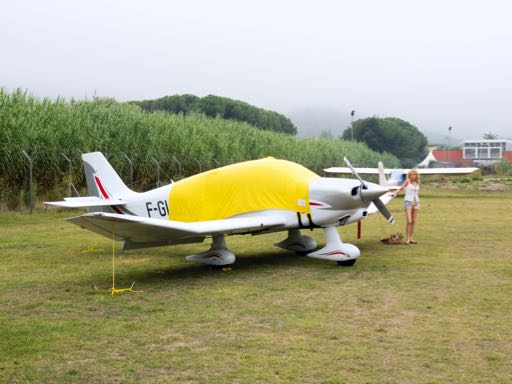
What about snow and ice?
A set of covers should prevent icing but, if ice catches you by surprise, then you may use AeroShell compound 07 or any chemically equivalent product. NO GLYCOL. Use the least fluid possible, applied with no force and no pressure. Fluid should NOT be sprayed into the fuselage or the wing where the controls exit. It is best to apply the fluid from a bucket using a sponge while wearing rubber gloves—no high temperatures and no high-pressure spray. Do not use de-icing fluid where the paint has cracked or is flaking and take especial care with the acrylic canopy.
If your aeroplane has a heavy ice coating then it should be placed in a hangar to allow the ice to melt naturally.
If your aeroplane has a heavy ice coating then it should be placed in a hangar to allow the ice to melt naturally.

What about de-icing in flight?
‘De-icing’ is really only a buffer to get the aircraft through icing conditions.
Flying a non-pressurised aircraft means you will tend to be flying in the weather, not above it. Even with oxygen the ceiling of the DR401 CDI is limited to 16,500 feet and the rate of climb approaching that level will be modest, potentially prolonging time in icing conditions.
An electrical de-icing system has been considered but has not been prioritised by the factory. There are several considerations:
Flying a non-pressurised aircraft means you will tend to be flying in the weather, not above it. Even with oxygen the ceiling of the DR401 CDI is limited to 16,500 feet and the rate of climb approaching that level will be modest, potentially prolonging time in icing conditions.
An electrical de-icing system has been considered but has not been prioritised by the factory. There are several considerations:
- Safety: in a non-pressurised aircraft with a fixed undercarriage a de-icing system could have limited benefit. The propellor and the leading edges of wing and empanage will be protected, but ice can still accumulate elsewhere, increasing mass and drag and degrading the aircraft's ability to climb, perhaps trapping it in icing conditions or forcing it to descend;
- Increased mass and, therefore, reduced payload;
- Cost.
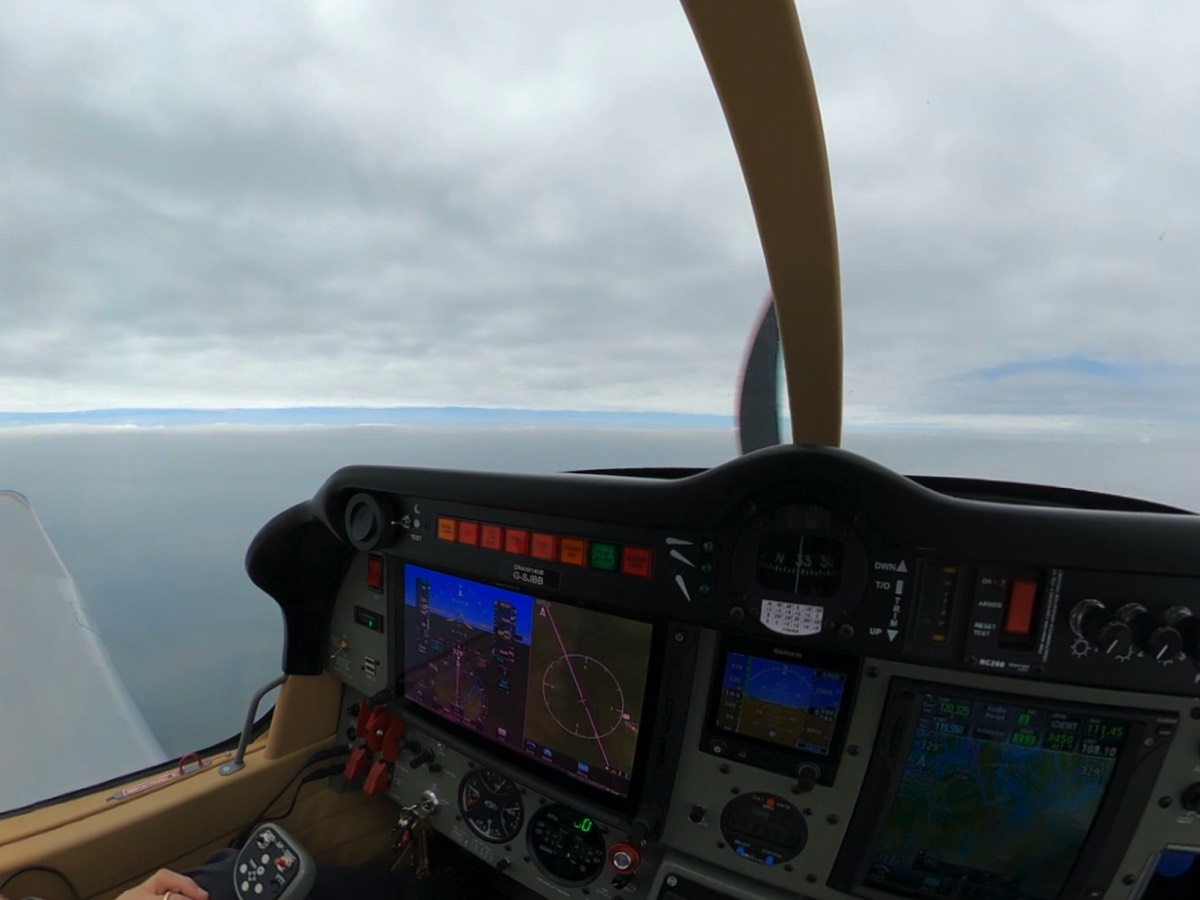
What glass cockpits are available for Robin aircraft?
In addition to the fitment of Garmin G5 units as standard:
- Certified options are Garmin G500TXi and Aspen 1500 / 2500 systems.
- Non-certified choices are Dynon Skyview 700, Flymap LD, Garmin 695 and G3X.
- An iPad can also be built onto the panel.
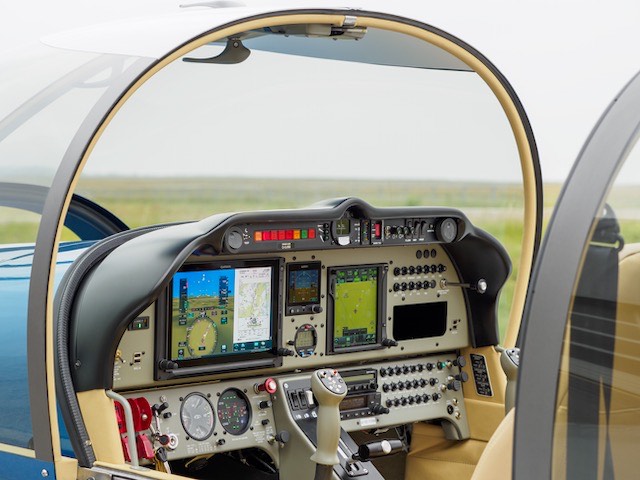
What are the advantages of the Continental Diesel engines?
Water cooled, FADEC controlled, fuel injected, and turbocharged the Continental Diesel engines offer these advantages over petrol engines:
- Comfort:
- Low noise (water cooled, efficient silencer);
- Low vibration;
- Performance:
- Turbocharging maintains power at altitude;
- Automatic, variable pitch propeller gives exceptional take-off performance;
- Low fuel consumption increases useful load and extends range;
- Economy:
- Uses Jet A-1 fuel (or automotive diesel, or most military jet fuels in any mixture) at 24 l/hr at 75% power;
- 100 hour or twelve month checks, whichever is the sooner (no 50 hour checks or additional 'annual';
- Safety:
- Sixteen times more reliable than other GA piston engines (in-flight shutdown rate 0·61 per 100,000 flight hours compared to 10 per 100,000 flight hours. Source: FAA via Continental Motors);
- Zero risk of carburettor icing;
- Zero risk of vapour lock;
- Zero risk of thermal shock on low power settings;
- Zero risk of carbon monoxide poisoning.
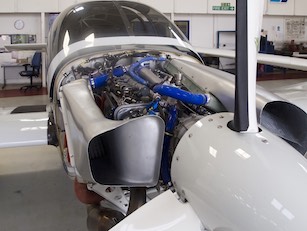
I have heard diesel engine overhauls are expensive, so where is the saving?
Fuel cost for the Robin DR401 155CDI is around £51 per flight hour less than for an Avgas powered equivalent. Even paying the tax for non-business use on Jet A-1 the saving is still about £25 per hour.
A gearbox inspection at 1,200 hours is about £3,500, but by that time you have saved between £44,000 and £61,000 on fuel.
An engine overhaul at 2,100 hours will cost about £45,000 but the owner will have recouped between £77,000 and £107,000 in fuel costs!
With a Continental diesel you have the most reliable piston engine in GA and a far more sophisticated power plant (low noise, low vibration, no shock cooling, no risk of carbon monoxide toxicity) than a petrol engine with the added bonus of significant cost savings.
A gearbox inspection at 1,200 hours is about £3,500, but by that time you have saved between £44,000 and £61,000 on fuel.
An engine overhaul at 2,100 hours will cost about £45,000 but the owner will have recouped between £77,000 and £107,000 in fuel costs!
With a Continental diesel you have the most reliable piston engine in GA and a far more sophisticated power plant (low noise, low vibration, no shock cooling, no risk of carbon monoxide toxicity) than a petrol engine with the added bonus of significant cost savings.
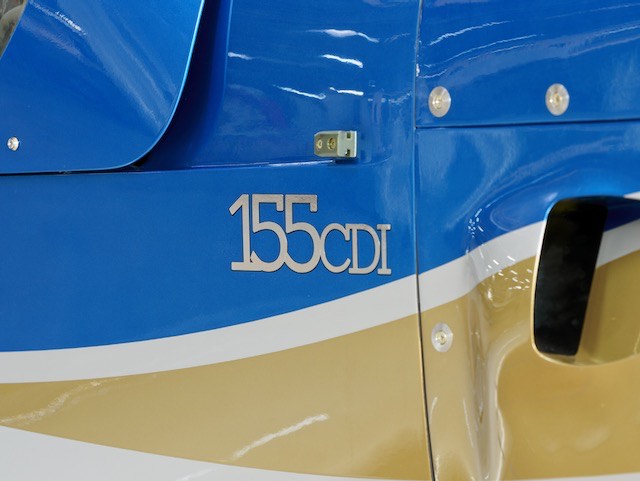
Where can I have my Continental Diesel engine serviced?
There are presently 25 service centres in the UK and Ireland and the network is expanding. There is even a mobile servicing unit for the Continental CDI; they will come to you!
You can access the worldwide service centres here.
You can access the worldwide service centres here.
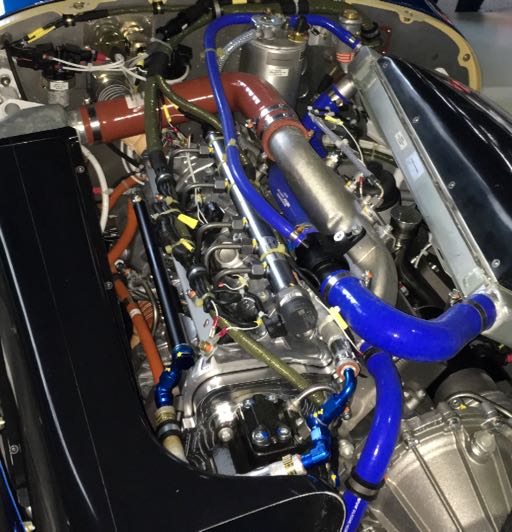
Can the Continental Diesel engine be retrofitted to my Robin aircraft?
Yes, if the serial number of your airframe is 2574 or later.
Retrofits to aircraft with the 140B wing were priced at around €100,000 ex VAT in January 2013, and prices have increased about 4% per annum since then. If your aircraft has the Régent wing (with wing root tanks) then you must additionally budget for a replacement wing (around €50,000 ex VAT in 2013).
Retrofits to aircraft with the 140B wing were priced at around €100,000 ex VAT in January 2013, and prices have increased about 4% per annum since then. If your aircraft has the Régent wing (with wing root tanks) then you must additionally budget for a replacement wing (around €50,000 ex VAT in 2013).
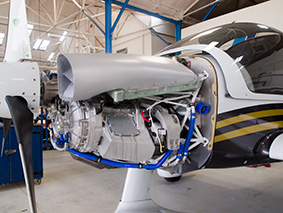
Will the Lycoming engines operate on UL 91 of Mogas?
Many Lycoming engines are approved for operation on UL 91 so long as Lycoming oil additive P/N LW-16702, or a functionally equivalent product such as Aeroshell 15W50, is used.
A specific Robin Aircraft conversion is required for Mogas, that can be installed at the time of manufacture.
A specific Robin Aircraft conversion is required for Mogas, that can be installed at the time of manufacture.
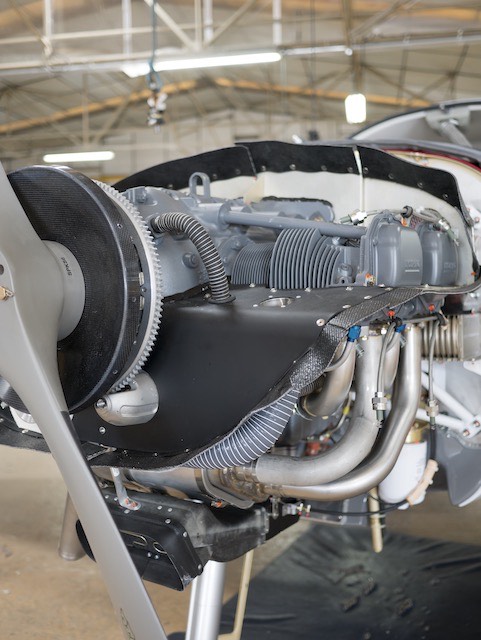
Can Robin aircraft be fitted with an airframe parachute?
Of the several systems available, Robin Aircraft have considered the BRS (ballistic recovery system), similar to that fitted by Cirrus, to offer as an option.
The characteristics of the system are:
In common with every other manufacturer of certified aircraft (except Cirrus) Robin Aircraft do not intend to offer a parachute as standard because the Robin DR401 does not need a parachute to meet its certification requirements and there are many disadvantages to having such a system installed:
BRS shortcomings are:
The leading causes of fatalities involving certified aircraft in GA are loss of control in flight (LoC-I; such as engine failure on take-off and low-level stalls), where, as with collisions in the circuit, height may be too low for the parachute to help, and controlled flight into terrain (CFIT) where a parachute is useless. The main circumstance where a parachute has been deployed successfully in certified aircraft in UK airspace has been loss of control in IMC (conditions that, allegedly, the pilot was not qualified or competent to fly in) after the autopilot became disconnected. Loss of control in IMC is relatively rare; lying in 8th place in the list of causes of fatalities in general aviation.
It is notable that the Cirrus had one of the worst accident records in GA soon after it was launched and that only improved to around average following the introduction by Cirrus of a training program for purchasers of new and used aircraft. The fact that the safety record of the Cirrus is only around average despite its parachute may be one reason why no other manufacturer of certified civilian aircraft offers a parachute installation.
Flying a heavy aircraft with relatively small wheels and a high stall speed into a field is quite likely to result in inversion and a poor outcome. In contrast, the DR401 with its relatively light weight, appropriate wheel size, low stall speed and excellent low speed handling is well suited to safely execute a forced landing.
As with many features in aircraft there is a balance to be struck in considering this one. The CDI engine is the most reliable piston engine in GA so even people who fly extensively at night, for example, may not consider the downsides of a BRS in a Robin worth accepting.
The characteristics of the system are:
- Rocket extraction;
- Controlled deployment by means of a ring that descends on the lines;
- 17 m diameter canopy;
- Descent at 25 feet per second.
In common with every other manufacturer of certified aircraft (except Cirrus) Robin Aircraft do not intend to offer a parachute as standard because the Robin DR401 does not need a parachute to meet its certification requirements and there are many disadvantages to having such a system installed:
BRS shortcomings are:
- The BRS unit and mountings weigh around 30 kg. It has to be placed in the tail section (thus moving the C of G aft) and requires parts of the airframe to be strengthened to withstand the forces associated with deployment, adding another 7 Kg. Combine weight and balance considerations and at least one passenger seat has been sacrificed for the same endurance.
- There is no control once the system is activated because the engine stops before deployment; and the descent speed is 25 feet per second…
- The system is airspeed limited:
- the aircraft must not exceed a set speed before deployment;
- if the aircraft is in free fall for a short time the parachute may not be able to withstand the load when it opens;
- if the structure breaks then there is virtually no chance of survival;
- If the system is deployed below 900 feet AGL it is unlikely that the aircraft will decelerate sufficiently for the subsequent impact to be survivable;
- The airframe will be written off;
- Costs increase:
- Increased purchase cost;
- Increased maintenance costs;
- Increased insurance premiums.
The leading causes of fatalities involving certified aircraft in GA are loss of control in flight (LoC-I; such as engine failure on take-off and low-level stalls), where, as with collisions in the circuit, height may be too low for the parachute to help, and controlled flight into terrain (CFIT) where a parachute is useless. The main circumstance where a parachute has been deployed successfully in certified aircraft in UK airspace has been loss of control in IMC (conditions that, allegedly, the pilot was not qualified or competent to fly in) after the autopilot became disconnected. Loss of control in IMC is relatively rare; lying in 8th place in the list of causes of fatalities in general aviation.
It is notable that the Cirrus had one of the worst accident records in GA soon after it was launched and that only improved to around average following the introduction by Cirrus of a training program for purchasers of new and used aircraft. The fact that the safety record of the Cirrus is only around average despite its parachute may be one reason why no other manufacturer of certified civilian aircraft offers a parachute installation.
Flying a heavy aircraft with relatively small wheels and a high stall speed into a field is quite likely to result in inversion and a poor outcome. In contrast, the DR401 with its relatively light weight, appropriate wheel size, low stall speed and excellent low speed handling is well suited to safely execute a forced landing.
As with many features in aircraft there is a balance to be struck in considering this one. The CDI engine is the most reliable piston engine in GA so even people who fly extensively at night, for example, may not consider the downsides of a BRS in a Robin worth accepting.
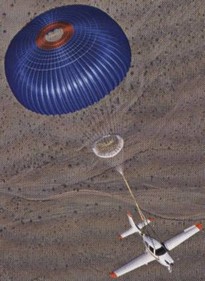
Selling your Robin aircraft through Mistral Aviation
There may come a time when you will want to sell your beloved Robin aircraft.
Why should have us value and market your aircraft? Because:
So, stand back and take a good look at it as if you were thinking of buying it. Take a fresh look at the interior, at the perspexes and the panel and ask yourself would you actually buy this plane?
Engine Hours: it is difficult to sell a plane if engine hours are approaching TBO either in hours or time, and extremely difficult if the engine is on extension past its TBO. Remember that some engines go 'on condition' at 12 years old, irrespective of hours, and some have to be replaced. Buyers will factor in a minimum of £14-£16k to zero hour a Lycoming engine, and the cost can be nearly that of a new engine. If engine hours are high then a recent top-end overhaul may help, but the message is that selling when the engine is old or has high hours is to be avoided.
Exterior condition: First impressions count for a lot. Repainting over existing paint adds weight and the finish will crack quickly due to flexing. So, with an older Robin a repaint usually means a re-cover. But an older Robin can be spruced up by careful cleaning and having the leading edges re-painted.
Perspex: A pre-owned aircraft will usually have some scratches in the perspex . Light scratches can be polished out with an electric buffer. Have it done by a professional as enthusiastic over polishing can weaken the perspex. Heavy scratches or cracks are a problem for a buyer, particularly in line of sight in the front perspexes.
Wheel spats and fairings: Simple fibre-glass repairs but can greatly enhance a first impression a buyer gets as he walks toward your plane.
Interior: A dirty interior with worn, damaged and faded fabric or leather creates a bad impression. Have the interior valeted professionally; it does not cost much and often can transform the look.
Avionics: We have rarely sold a plane where the buyer is happy with the existing avionics, so it is best not to have a comprehensive and expensive avionics upgrade just before selling. It is a good idea to have a Mode S transponder and at least one 8·33 kHz radio fitted and all the other avionics must be working; an avionic unit with a U/S placard next to it is unsurprisingly off-putting!
Documentation: Make sure that all the aircraft documents are ready for inspection and neatly presented. A list of SB and AD compliance and time-lifed component replacement is essential. Your workshop should be able to print one on request.
As a proud owner you may not think that ALL these things need attending to but just doing some will increase the prospect of finding a buyer.
When you place your plane with us we shall inspect it and advise.—and remember FIRST IMPRESSIONS COUNT!
Why should have us value and market your aircraft? Because:
- We know the product and monitor the market, so we can give a realistic valuation. Overvaluing leads to disappointment and delays, whilst the aircraft continues to depreciate;
- Advertising is very expensive. We get preferential rates because we advertise regularly;
- Managing an aircraft sale requires a lot of paperwork, particularly when selling abroad, all of which we handle.
So, stand back and take a good look at it as if you were thinking of buying it. Take a fresh look at the interior, at the perspexes and the panel and ask yourself would you actually buy this plane?
Engine Hours: it is difficult to sell a plane if engine hours are approaching TBO either in hours or time, and extremely difficult if the engine is on extension past its TBO. Remember that some engines go 'on condition' at 12 years old, irrespective of hours, and some have to be replaced. Buyers will factor in a minimum of £14-£16k to zero hour a Lycoming engine, and the cost can be nearly that of a new engine. If engine hours are high then a recent top-end overhaul may help, but the message is that selling when the engine is old or has high hours is to be avoided.
Exterior condition: First impressions count for a lot. Repainting over existing paint adds weight and the finish will crack quickly due to flexing. So, with an older Robin a repaint usually means a re-cover. But an older Robin can be spruced up by careful cleaning and having the leading edges re-painted.
Perspex: A pre-owned aircraft will usually have some scratches in the perspex . Light scratches can be polished out with an electric buffer. Have it done by a professional as enthusiastic over polishing can weaken the perspex. Heavy scratches or cracks are a problem for a buyer, particularly in line of sight in the front perspexes.
Wheel spats and fairings: Simple fibre-glass repairs but can greatly enhance a first impression a buyer gets as he walks toward your plane.
Interior: A dirty interior with worn, damaged and faded fabric or leather creates a bad impression. Have the interior valeted professionally; it does not cost much and often can transform the look.
Avionics: We have rarely sold a plane where the buyer is happy with the existing avionics, so it is best not to have a comprehensive and expensive avionics upgrade just before selling. It is a good idea to have a Mode S transponder and at least one 8·33 kHz radio fitted and all the other avionics must be working; an avionic unit with a U/S placard next to it is unsurprisingly off-putting!
Documentation: Make sure that all the aircraft documents are ready for inspection and neatly presented. A list of SB and AD compliance and time-lifed component replacement is essential. Your workshop should be able to print one on request.
As a proud owner you may not think that ALL these things need attending to but just doing some will increase the prospect of finding a buyer.
When you place your plane with us we shall inspect it and advise.—and remember FIRST IMPRESSIONS COUNT!
